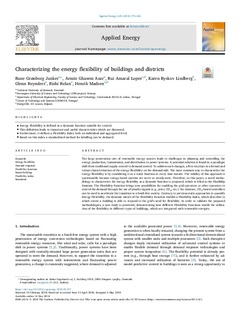| dc.contributor.author | Junker, Rune Grønborg | |
| dc.contributor.author | Azar, Armin Ghasem | |
| dc.contributor.author | Lopes, Rui | |
| dc.contributor.author | Lindberg, Karen Byskov | |
| dc.contributor.author | Reynders, Glenn | |
| dc.contributor.author | Relan, Rishi | |
| dc.contributor.author | Madsen, Henrik | |
| dc.date.accessioned | 2019-03-06T13:18:40Z | |
| dc.date.available | 2019-03-06T13:18:40Z | |
| dc.date.created | 2018-05-15T13:07:49Z | |
| dc.date.issued | 2018 | |
| dc.identifier.citation | Applied Energy. 2018, 225 175-182. | nb_NO |
| dc.identifier.issn | 0306-2619 | |
| dc.identifier.uri | http://hdl.handle.net/11250/2589042 | |
| dc.description.abstract | The large penetration rate of renewable energy sources leads to challenges in planning and controlling the energy production, transmission, and distribution in power systems. A potential solution is found in a paradigm shift from traditional supply control to demand control. To address such changes, a first step lays in a formal and robust characterization of the energy flexibility on the demand side. The most common way to characterize the energy flexibility is by considering it as a static function at every time instant. The validity of this approach is questionable because energy-based systems are never at steady-state. Therefore, in this paper, a novel methodology to characterize the energy flexibility as a dynamic function is proposed, which is titled as the Flexibility Function. The Flexibility Function brings new possibilities for enabling the grid operators or other operators to control the demand through the use of penalty signals (e.g., price, CO2, etc.). For instance, CO2-based controllers can be used to accelerate the transition to a fossil-free society. Contrary to previous static approaches to quantify Energy Flexibility, the dynamic nature of the Flexibility Function enables a Flexibility Index, which describes to which extent a building is able to respond to the grid’s need for flexibility. In order to validate the proposed methodologies, a case study is presented, demonstrating how different Flexibility Functions enable the utilization of the flexibility in different types of buildings, which are integrated with renewable energies. | nb_NO |
| dc.language.iso | eng | nb_NO |
| dc.publisher | Elsevier | nb_NO |
| dc.rights | Navngivelse 4.0 Internasjonal | * |
| dc.rights.uri | http://creativecommons.org/licenses/by/4.0/deed.no | * |
| dc.title | Characterizing the energy flexibility of buildings and districts | nb_NO |
| dc.type | Journal article | nb_NO |
| dc.type | Peer reviewed | nb_NO |
| dc.description.version | publishedVersion | nb_NO |
| dc.source.pagenumber | 175-182 | nb_NO |
| dc.source.volume | 225 | nb_NO |
| dc.source.journal | Applied Energy | nb_NO |
| dc.identifier.doi | 10.1016/j.apenergy.2018.05.037 | |
| dc.identifier.cristin | 1585136 | |
| dc.relation.project | Norges forskningsråd: 257660 | nb_NO |
| dc.description.localcode | © 2018 The Authors. Published by Elsevier Ltd. This is an open access article under the CC BY license (http://creativecommons.org/licenses/BY/4.0/) | nb_NO |
| cristin.unitcode | 194,63,20,0 | |
| cristin.unitcode | 194,0,0,0 | |
| cristin.unitname | Institutt for elkraftteknikk | |
| cristin.unitname | Norges teknisk-naturvitenskapelige universitet | |
| cristin.ispublished | true | |
| cristin.fulltext | original | |
| cristin.qualitycode | 1 | |

